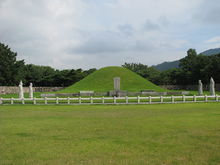Suro of Geumgwan Gaya
| Gim Suro 金首露 김수로 | |
|---|---|
| King of Geumgwan Gaya | |
| Successor | Geodeung of Geumgwan Gaya |
| Died | 199 |
| Spouse | Heo Hwang-ok |
| Suro of Geumgwan Gaya | |
 Tomb of King Suro in Gimhae | |
| Korean name | |
|---|---|
| Hangul | 수로왕 |
| Hanja | 首露王 |
| Revised Romanization | Suro-wang |
| McCune–Reischauer | Suro-wang |


Suro (수로) or Sureung (posthumous name: 수릉, 首陵, 42?–199), commonly called Kim Suro, was the legendary founder and King of Geumgwan Gaya (43–532), in southeastern Korea.[1]
Family[]
- Spouse: [[Heo Hwang-ok|Heo Hwang-ok/Sembavalam
- Geodeung of Gaya-the 2nd King of Gaya
- nine sons (two became the ancestors of the Heo clan)
- Princess Myogyeon (묘견공주)
Legend[]
According to the founding legend of Geumgwan Gaya, which was recorded in the 13th century texts of the chronicle Garakguk-gi (hangul: 가락국기, hanja: 駕洛國記) and was cited in Samguk Yusa, when the people who were commanded by heaven performed ancestral rites, danced and sang, a gold bowl wrapped in red cloth came down from heaven. There were six eggs in them, and 12 days later six princes were born from the eggs.[2] Suro was the firstborn among them and led the others in setting up six states while asserting the leadership of the Gaya confederacy.[1][3]
Also according to legend, King Suro's wife, Heo Hwang-ok or Sembavalam was a princess from a distant country called Ayuta 아유타, 阿踰, also implied to be in India.[4][5]
The legend as a whole is seen as indicative of the early view of kings as descended from heaven. Notably, a number of Korean Kingdoms besides the Gaya, made foundation legends with ties to chickens and eggs. Jumong, the founding King of Goguryeo, is said to have been born from an egg laid by Lady Yuhwa; Bak Hyeokgeose, the first King of Silla (or Saro-guk) is said to have hatched from an egg discovered in a well; and Gim Al-ji, the progenitor of the Kim dynasty of Silla, is said to have been discovered in Gyerim Forest by Hogong in a golden box, where a rooster was crowing. Aspects of the legend have been mined for information about the customs of Gaya, of which little is known.[3]
Incorporation of tomb into the Silla ancestor worship[]
At the time of King Munmu, the spirit tablet of Suro was temporarily respected along with fellow Silla Kings, as Munmu was his 15th grandson. According to Samguk Yusa, Munmu ordered the Jesa (revering ritual in confucian traditions) of King Suro.
In modern culture[]
Tomb and descendants[]
A tomb attributed to King Suro is still maintained in modern-day Gimhae.[6][7] Members of the Gimhae Kim clan, who continue to play important roles in Korean life today, trace their ancestry to King Suro, as do the members of the Incheon Lee and Gimhae Heo clan; they did not inter-marry until the beginning of the 20th century.[8]
Television series[]
- Portrayed by Ji Sung and Park Gun-tae in the 2010 MBC TV series Kim Su-ro, The Iron King.[9]
See also[]
- List of Korean monarchs
- History of Korea
- List of Korea-related topics
- Three Kingdoms of Korea
References[]
- ^ a b (in Korean) King Gim Suro Archived 2011-06-10 at the Wayback Machine at Britannica Korea
- ^ "김수로왕". terms.naver.com (in Korean). Retrieved 2021-05-02.
- ^ a b (in Korean) King Gim Suro Archived 2011-06-10 at the Wayback Machine at Encyclopedia of Korean Culture
- ^ Robert E. Buswell (1991). Tracing Back the Radiance: Chinul's Korean Way of Zen. University of Hawaii Press. p. 74. ISBN 978-0-8248-1427-4.
- ^ Skand R. Tayal (2015). India and the Republic of Korea: Engaged Democracies. Taylor & Francis. p. 23. ISBN 978-1-317-34156-7.
- ^ (in Korean) Tomb of King Suro at Doosan Encyclopedia
- ^ (in Korean) Tomb of King Suro Archived 2011-06-10 at the Wayback Machine at Encyclopedia of Korean Culture
- ^ (in Korean) Gim of Suro clan, Korean surname info
- ^ Kim, Lynn (5 March 2010). "Ji Sung to star in new TV series Kim Su-ro". 10Asia. Retrieved 2013-02-15.
Bibliography[]
- Kwon, J.H. (권주현) (2003). Life and culture of the Gaya people (가야인의 삶과문화). Seoul: Hyean. ISBN 978-89-8494-221-9.
- Lee, K.-b.; E.W. Wagner; E.J. Schulz (1984). A new history of Korea. Seoul: Ilchogak. ISBN 978-89-337-0204-8.
- Lee, Hee Geun (이희근) (2005). Thematic history of Korea (주제로 보는 한국사). Seoul: Godswin. pp. 23–24. ISBN 978-89-91319-51-6.
External links[]
- Tomb of King Suro Life in Korea
- Gaya Culture Festival
- Gim Suro, TV drama from MBC
- Gaya rulers
- Gimhae Kim clan
- 2nd-century monarchs in Asia
- 1st-century monarchs in Asia
- 199 deaths